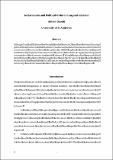Files in this item
Sectarianism and political order in Iraq and Lebanon
Item metadata
| dc.contributor.author | Saouli, Adham | |
| dc.date.accessioned | 2021-04-11T23:45:41Z | |
| dc.date.available | 2021-04-11T23:45:41Z | |
| dc.date.issued | 2019-04-12 | |
| dc.identifier | 258099194 | |
| dc.identifier | 22167cf6-1c80-4779-b5e4-0e302f1d5437 | |
| dc.identifier | 85064159997 | |
| dc.identifier | 000464956100004 | |
| dc.identifier.citation | Saouli , A 2019 , ' Sectarianism and political order in Iraq and Lebanon ' , Studies in Ethnicity and Nationalism , vol. 19 , no. 1 , pp. 67-87 . https://doi.org/10.1111/sena.12291 | en |
| dc.identifier.issn | 1473-8481 | |
| dc.identifier.other | ORCID: /0000-0002-4118-2627/work/76387372 | |
| dc.identifier.uri | https://hdl.handle.net/10023/23007 | |
| dc.description.abstract | Although Iraq and Lebanon are deeply divided societies, they have followed varying political trajectories. Whilst Lebanon has accommodated sectarianism within a consociational democracy since its inception, until 2003 Iraq had an authoritarian regime that ostensibly repressed sectarianism. However, after 2003, Iraqi politics began to converge with the consociationalism of Lebanon. Taking a longitudinal approach, this study explains this puzzle by focusing on one factor: sectarianism. It asks how and why sectarianism has shaped the political trajectories and regime types in the two cases and, conversely, how sectarianism has been shaped by these trajectories and regimes. | |
| dc.format.extent | 585023 | |
| dc.language.iso | eng | |
| dc.relation.ispartof | Studies in Ethnicity and Nationalism | en |
| dc.subject | JZ International relations | en |
| dc.subject | T-NDAS | en |
| dc.subject | BDC | en |
| dc.subject | R2C | en |
| dc.subject.lcc | JZ | en |
| dc.title | Sectarianism and political order in Iraq and Lebanon | en |
| dc.type | Journal article | en |
| dc.contributor.institution | University of St Andrews. School of International Relations | en |
| dc.identifier.doi | 10.1111/sena.12291 | |
| dc.description.status | Peer reviewed | en |
| dc.date.embargoedUntil | 2021-04-12 |
This item appears in the following Collection(s)
Items in the St Andrews Research Repository are protected by copyright, with all rights reserved, unless otherwise indicated.

